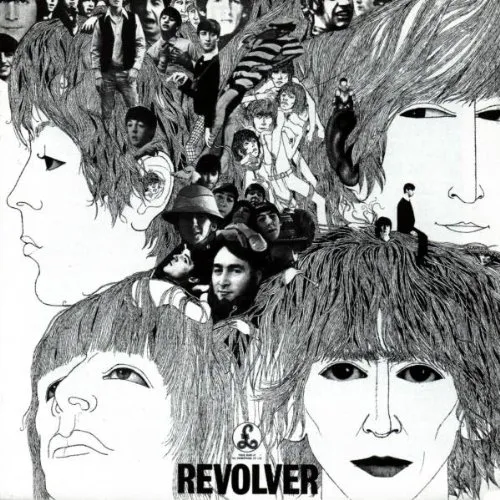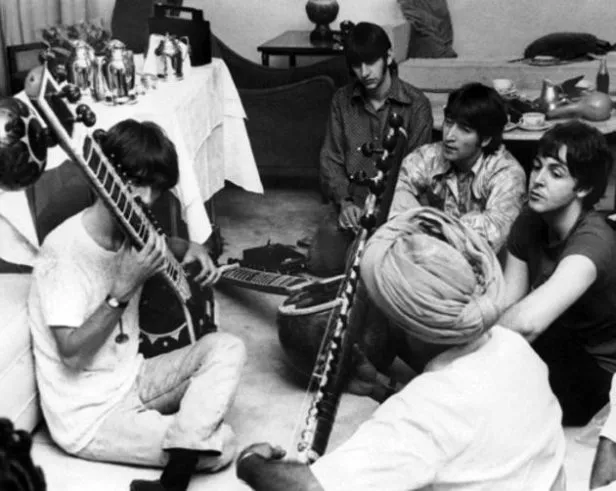
The cover illustration for the Revolver album created by German-born bassist and artist Klaus Voormann.
“The whole point is that we are the song.
"The self is coming from a state of pure awareness, from the state of being. All the rest that comes about in the outward manifestation of the physical world (including all the fluctuations which end up as thoughts and actions) is just clutter. The true nature of each soul is pure consciousness. So the song is really about transcending and about the quality of the transcendent.”
– George Harrison on the creation of the song Tomorrow Never Knows
The Backdrop
Growing tired of the scrutiny of the international limelight, feeling drained from the continuous pressure to produce meaningless jingles and shallow pop hits, the members of the Beatles (especially John Lennon and George Harrison) did what all people eventually do: They returned home. In this case, they turned inward to the soul, the seat of one’s being that ever seeks meaning in a world embroiled in endless personal, social, and geopolitical conflict. While Paul and Ringo both sought their own paths in seemingly less public venues, John and George took the first openly brave steps on the long journey inward.
Fresh out of the Korean War and now fully embroiled in the Vietnam conflict, the western war machine sought to silence the very thing that could have saved a thirsty occidental soul: the Orient – an endless treasure trove of ancient teachings backed by thousands of years of tradition and practical application.
Eastern Influence
Aside from the Beatles, numerous other musicians and creative leaders drew their inspiration from the East for answers. However, with China locked away during Mao’s isolationist regime, Saudi Arabia still embroiled deeply in inter-tribal strife, and Japan still rebuilding from its humiliating defeat following the atomic bombings of Hiroshima and Nagasaki, the answers that the East willingly offered were limited. With other parts of the Orient either still caught up in conflict, or shunning the encroachment of Western influences, the only open doorway at the time was India.
Despite having formally established independence in 1947, India had adopted many of the ways of its former master, and thus in many ways was still considered a satellite province of the British empire. As citizens of the UK, John Lennon and George Harrison held a de facto tie with India. With this gate to the East now open, the Beatles (especially Harrison) made their way into the still-unexplored waters of Indian culture.

The band studies Indian music.
In due time Harrison was introduced to and befriended the Indian musician Ravi Shankar. For many years following, Shankar influenced Harrison, who in turn passed on his affinity for eastern ways to Lennon. Amidst rampant drug experimentation and the free-love concept of the 1960s, more disciplined and time-tried practices such as meditation and asceticism were brought into the mainstream western consciousness through both Harrison and Lennon.
As psychologist Carl Jung would say, the process of individuation begins in early adulthood, and many times comes with it a fervent emergence of the individual as a powerful entity unto itself. This said, both Lennon and Harrison (and later indeed all of the Beatles) began to drift apart until their eventual breakup.
But, before the group’s formal breakup, there appeared a song so powerful, so unique, that it was forever to change the ways that many people would look into spiritual exploration via the medium of music. The song was known as Tomorrow Never Knows (listen here), which appeared on the Beatles’ Revolver album.
The “Jump from the Cliff”
As Rolling Stone magazine said it:
“The last and most aggressively experimental track on [the] Revolver [music album] was the first to be recorded: Lennon’s rapid, excited response to the great escape of LSD. In acid, Lennon found his first true relief from the real world and the band’s celebrity — an alternate space of rapture and self-examination that he re-created, with the energized collaboration of the other Beatles, in “Tomorrow Never Knows.” All of a sudden, the poetic advance and rustic modernism of Rubber Soul — issued only five months before these sessions, in December 1965 — was very old news.
“Compared to the rolling drone, tape-loop effects and out-of-body vocals that dominate Lennon’s trip here, even the rest of Revolver sounds like mutation in process: the Beatles pursuing their liberated impulses as players and writers, via acid, in pop-song form. There was no other place for this track on the album but the end. “Eleanor Rigby,” “I’m Only Sleeping,” “Love You To” and “She Said She Said” were all bold steps toward the unknown — but “Tomorrow Never Knows” was the jump from the cliff.”
A Work of Art
Despite any debunking drawn from talk of the song being inspired by an acid-induced state of limbo, the song is a work of pure inspiration in itself – both as a sound studio work, and a listening piece.
From the innovative use of revolving Leslie speakers, to the backwards-played tracks of ordinary sounds like the “seagulls” (or “space bunnies” as I like to call them), sometimes sped up or slowed down, to the admixture of Indian instrumentation such as the sitar, and Ringo’s admirably unstoppable mono-track drumbeat, the state or mind that Tomorrow Never Knows induces is relaxing at the least, and transcendental at its most powerful.
In spite of the tumultuous backdrop from which it sprang, Tomorrow Never Knows indeed extracts itself as a work of art. In the sense that both the word “work” and “art” essentially mean the same thing at their root, the song is a product of creativity risen from the hours-long effort put in at the music studio, and emerges again and again in these years passed as a beautiful gift of sound to listeners both young and old.
© 2016 - John Melendez - All rights reserved worldwide